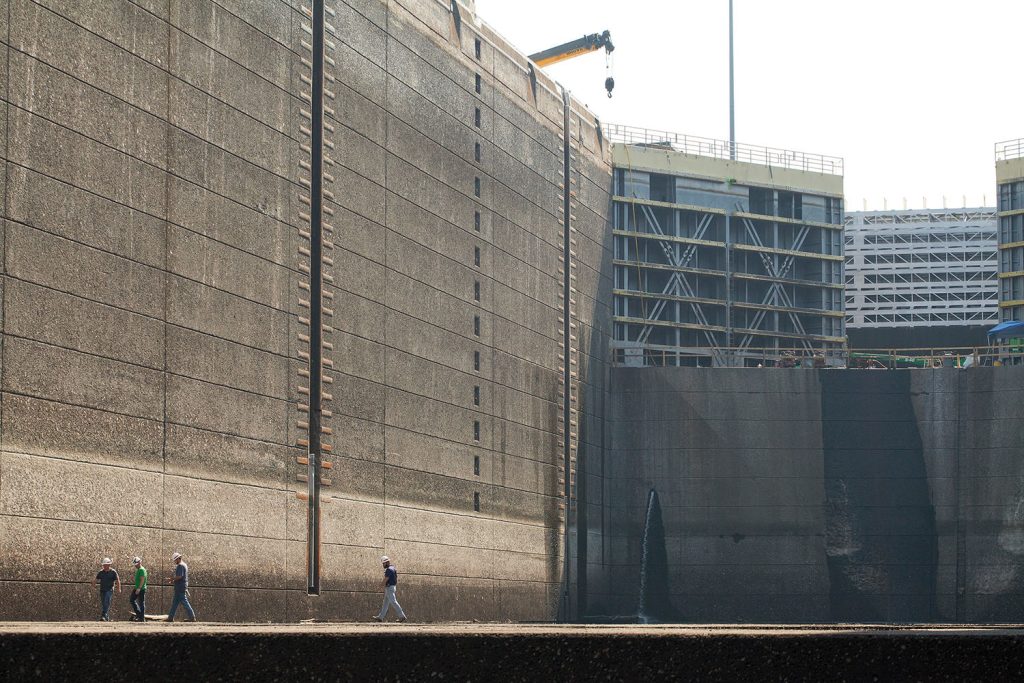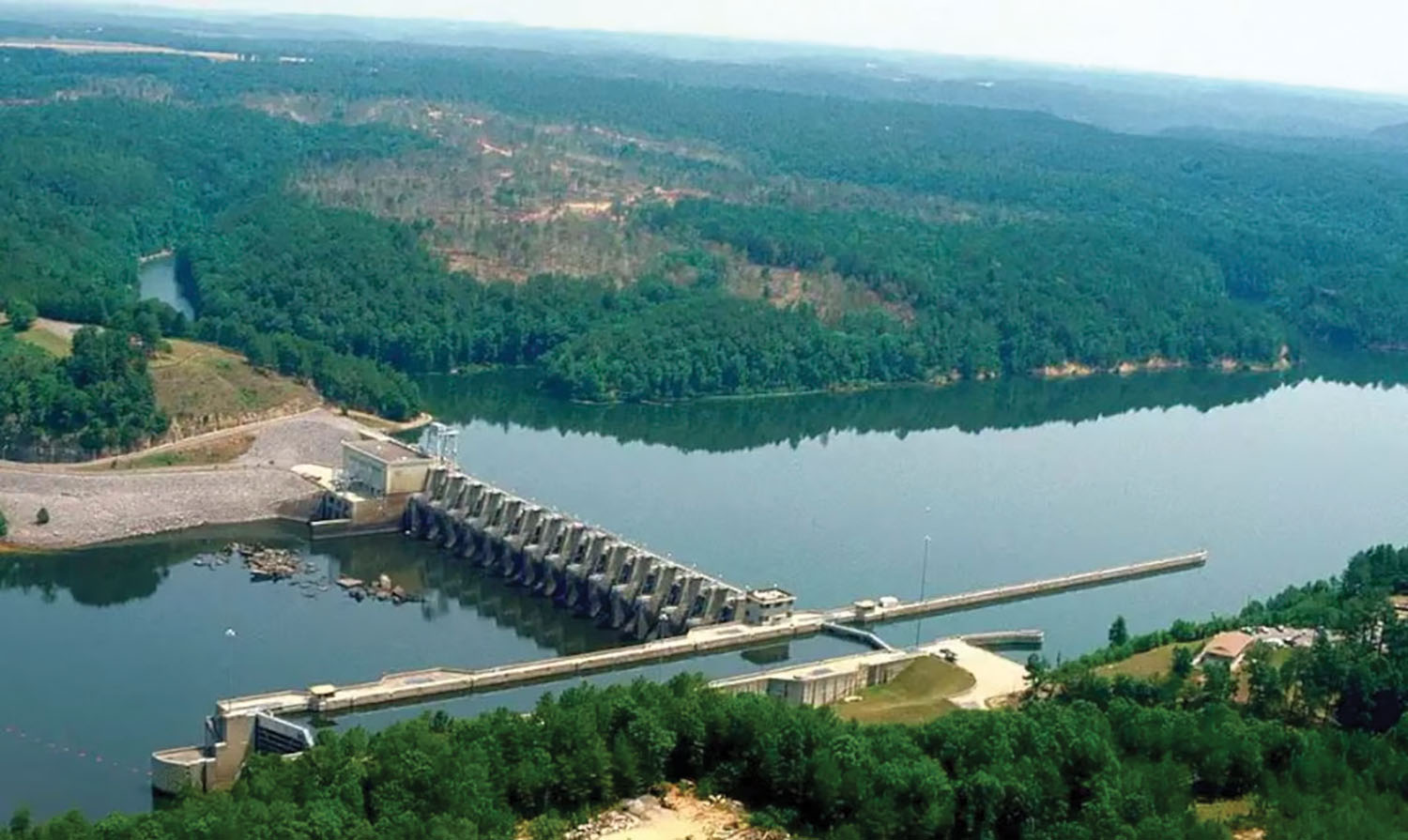The Mobile Engineer District has ordered the emergency closure of Holt Lock on the Black Warrior River in Tuscaloosa, Ala., following the appearance of new cracks and a stability analysis that detected movement of the lock chamber monolith that adjoins the dam.
Holt Lock is one of three Corps structures within a 30-mile stretch of the Black Warrior River that collectively handle a 160-foot drop in elevation. Located at Black Warrior River Mile 347, Holt Lock, which opened in 1966, accounts for a whopping 64-foot lift.
Col. Jeremy Chapman, commander of the Mobile District, ordered the closure at Holt to begin at noon June 22. The closure, which notably affects coal shipments moving down from northeast Tuscaloosa and Jefferson counties, comes on the heels of a months-long closure at Demopolis Lock at the lower end of the system. Demopolis Lock suffered a failure of its upper miter sill in mid-January.
Speaking during a June 24 stakeholders conference call, Nelson Sanchez, operations division chief for the Mobile District, said his team has been aware of some cracks in the spillway-side monolith for eight or nine years. Over that time, though, the monolith remained stable. About a month ago, things changed.
At that time, the lock operator, conducting a normal visual inspection, noticed additional cracking in the concrete monolith. The lock operator then alerted Anthony Perkins, project manager for the Black Warrior-Tombigbee Waterway project, who relayed the concern to the district. Sanchez said his team measured the new cracks to compare them to the known cracks from years ago. The team also installed equipment to detect shifts in the chamber. Sanchez said his team recorded “some serious movement of that monolith.”
“The last two weeks, it’s gotten even worse,” he said.
Sanchez said a stability analysis identified a safety factor of 0.5, less than half what the Corps typically expects.
Chapman personally visited the lock and said he actually could see the monolith moving. When Chapman saw that, he knew he had to order its closure, he said.
“Because again, we’re risking the lives of the folks in the chamber, your tow crews,” he said. “We’re also risking the lives of the operators of the lock who are in that lock control station. If that monolith goes, that whole [lock control] building goes into the chamber. And it’s to the point that, if we were to lose that entire monolith, we would lose a piece of that spillway. So this wouldn’t be Demopolis. This would be 10 times worse than Demopolis.”
A catastrophic failure like that, Chapman said, would likely require cofferdams and a much longer timeline for repair than the four-month closure at Demopolis.
“We’re looking at a two-, three-year fix if that were to happen,” Chapman said. “And that’s an extreme risk that we just can’t afford to happen. We want to be able to control it.”
Paul Kavinoky, president of the Alabama Mining Association, spoke up and asked the question on every stakeholder’s mind: “Are we talking days, weeks, months?”
“It’s not days,” Chapman said. “There’s not a real quick fix. I would like it to be days, but it’s more like weeks or months at this point, but we don’t know.”

Sanchez said his team is working seven days a week to identify a fix. Following that, district leaders will develop an equipment and materials acquisition strategy, seek funding, establish a “battle rhythm” for communications, adopt a repair schedule and consider a plan for any potential emergency lockages. The acquisition strategy, Sanchez said, will likely involve one of three alternatives: using the Mobile District’s own floating plant, with R&D Maintenance as the general contractor, much like with the repair at Demopolis; partnering with Nashville District’s repair fleet; or contracting it out to a private party.
One thing Sanchez emphasized was, while the issue at Holt is serious, it’s something the Corps is familiar with.
“This is not a new thing to have a problem with monoliths at locks,” Sanchez said. “Other locks have seen some very serious situations … so we have those experts. That’s a positive thing. We didn’t have a fix for Demopolis. That was totally new.”
Tim Parker III, president and CEO of Parker Towing Company, said that bit of news gave him hope the Corps will be able to address the issue at Holt expeditiously.
“The Corps has seen it,” he said. “They’ve studied it.”
More than anything, the issue at Holt highlights the age and increasing fragility of infrastructure in the United States.
“I think the biggest thing for us is it reinforces the need to invest in infrastructure in this country, especially locks and dams,” Parker said.
Members of Alabama’s congressional delegation are already aware of the issue, Parker said, and waterway stakeholders are pushing for the funding needed to execute repairs at Holt.
In the meantime, miners, business and industry above the lock remain in limbo. For four months this spring, with Demopolis Lock closed and both the Black Warrior-Tombigbee and Tennessee-Tombigbee waterways cut off from the Port of Mobile, most shippers and operators were forced to hunker down and wait for the lock to reopen. Demopolis reopened to navigation on May 16, but that 38-day window leading up to the closure at Holt wasn’t enough to get back to normal.
“It hasn’t come close,” Parker said.
The vast majority of tonnage that passes through Holt Lock, along with Bankhead Lock, 18 miles upriver, is coal, namely metallurgical coal bound for the Port of Mobile’s McDuffie Coal Terminal. Besides that, alloys and raw materials move northbound to supply Birmingham’s steel industry.
“Everybody’s got a backlog from the Demopolis closure, and this is just going to exacerbate the issue,” Parker said.
Caption for top photo: An undated aerial view of Holt Lock on the Black Warrior River in Tuscaloosa, Ala. (Photo courtesy of the Mobile Engineer District)




